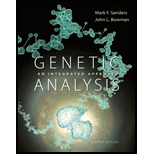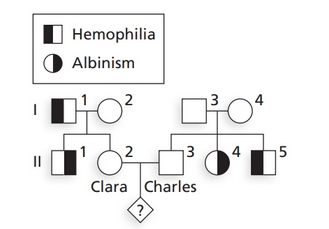
Concept explainers
In humans, hemophilia A (OMIM 306700) is an X-linked recessive disorder that affects the gene for factor VIII protein, which is essential for blood clotting. The dominant and recessive alleles for the factor VIII gene are represented by H and h. Albinism is an autosomal recessive condition that results from mutation of the gene producing tyrosinase, an enzyme in the melanin synthesis pathway. A and a represent the tyrosinase alleles. A healthy woman named Clara (II-2), whose father (I-1) has hemophilia and whose brother (II-1) has albinism, is married to a healthy man named Charles (II-3), whose parents are healthy. Charles’s brother (II-5) has hemophilia, and his sister (II-4) has albinism. The pedigree is shown below.

a. What are the genotypes of the four parents (I-1 to I-4) in this pedigree?
b. Determine the probability that the first child of Clara and Charles will be a
i. boy with hemophilia
ii. girl with albinism
iii. healthy girl
iv. boy with both albinism and hemophilia
v. boy with albinism
vi. girl with hemophilia
c. If Clara and Charles’s first child has albinism, what is the chance the second child has albinism? Explain why this probability is higher than the probability you calculated in part (b).
Learn your wayIncludes step-by-step video

Chapter 3 Solutions
Genetic Analysis: An Integrated Approach (2nd Edition)
Additional Science Textbook Solutions
Anatomy & Physiology
Campbell Essential Biology with Physiology (6th Edition)
Campbell Essential Biology (6th Edition) - standalone book
Campbell Biology in Focus (2nd Edition)
Anatomy & Physiology (6th Edition)
Microbiology with Diseases by Body System (5th Edition)
- Junctional epidermolysis bullosa (JEB) is a severe skin disorder that results in blisters over the entire body. The disorder is caused by autosomal recessive mutations at any one of three loci that help to encode laminin 5, a major component in the dermal–epidermal basement membrane. Leena Pulkkinen and colleagues described a male newborn who was born with JEB and died at 2 months of age (L. Pulkkinen et al. 1997. American Journal of Human Genetics 61:611–619); the child had healthy, unrelated parents. Chromosome analysis revealed that the infant had 46 normal-appearing chromosomes. Analysis of DNA showed that his mother was heterozygous for a JEB-causing allele at the LAMB3 locus, which is on chromosome 1. The father had two normal alleles at this locus. DNA fingerprinting demonstrated that the male assumed to be the father had, in fact, conceived the child. Q. How might you go about proving your explanation? Assume that a number of genetic markers are available for each chromosome.arrow_forwardAnhidrotic ectodermal dysplasia is an X-linked recessive disorder in humans characterized by small teeth, no sweat glands, and sparse body hair. This trait is usually seen in men, but women who are heterozygous carriers of the trait often have irregular patches of skin with few or no sweat glands (see the illustration below). a. Explain why women who are heterozygous carriers of a recessive gene for anhidrotic ectodermal dysplasia have irregular patches of skin lacking sweat glands. b. Why does the distribution of the patches of skin lacking sweat glands differ among the females depicted in the illustration, even between the identical twins?arrow_forwardLesch-Nyhan syndrome is due to a mutation in a gene that encodesa protein called hypoxanthine-guanine phosphoribosyltransferase(HPRT). HPRT is an enzyme that functions in purine metabolism.People afflicted with this syndrome have severe neurodegenerationand loss of motor control. The pedigree below contains severalindividuals with Lesch-Nyhan syndrome, shown with blacksymbols. Based on this pedigree, does this syndrome appearto be inherited by an autosomal recessive, autosomal dominant,X-linked recessive, or X-linked dominant pattern? Explainyour reasoning.arrow_forward
- Amelogenesis imperfecta (AI) is a disorder of faulty tooth enamel formation. It is inherited in an autosomal dominant and X-linked dominant pattern. The expression of AI disorder is determined by mutations in the autosomal alleles. One copy of the mutated allele (A) will cause the disorder. The severity of the disorder is determined by mutations in a gene carried on the X chromosome. Normal (or non-severe) abnormality (XN) is dominant over the abnormality (or severe) (Xn) allele. In the absence of the autosomal dominant allele, the abnormality gene on the X chromosome is notexpressed. Question:A woman with normal teeth had four children with a man with non-severe form of AI: A boy was born without amelogenesis imperfecta A girl was born without amelogenesis imperfecta A boy was born with severe amelogenesis imperfecta A boy was born with non severe amelogenesis imperfecta Identify the parental genotypes. Complete the Punnett square for the parental cross, and identify the possible…arrow_forwardAmelogenesis imperfecta (AI) is a disorder of faulty tooth enamel formation. It is inherited in an autosomal dominant and X-linked dominant pattern. The expression of AI disorder is determined by mutations in the autosomal alleles. One copy of the mutated allele (A) will cause the disorder. The severity of the disorder is determined by mutations in a gene carried on the X chromosome. Normal (or non-severe) abnormality (XN) is dominant over the abnormality (or severe) (Xn) allele. In the absence of the autosomal dominant allele, the abnormality gene on the X chromosome is not expressed. Question:A woman with normal teeth had four children with a man with non-severe form of AI: A boy was born without amelogenesis imperfecta A girl was born without amelogenesis imperfecta A boy was born with severe amelogenesis imperfecta A boy was born with non severe amelogenesis imperfecta Identify the parental genotypes. Complete the Punnett square for the parental cross, and identify the…arrow_forwardRetinitis pigmentosa, a group of related eye disorders that cause progressive vision loss, is due to an autosomal dominant allele. Tay-Sachs disease, on the other hand, is due to a defective gene with incomplete dominance. A mutation in the recessive HEXA gene prevents the synthesis of the lysosome enzyme beta-hexosaminidase A. This mutation prevents the breakdown of GM2 ganglioside, thus increasing to a toxic level that damages neurons. Luisa is a carrier of the allele for Tay-Sachs but has no sign of any eye disorder in her family. She married Gerard whose mother was afflicted with retinitis pigmentosa, unlike his father. Neither of his parents has any history of Tay-Sachs disease. What are the genotypes of Luisa and Gerard? Luisa:______________________________Gerard:_____________________________arrow_forward
- Amelogenesis imperfecta (AI) is a disorder of faulty tooth enamel formation. It is inherited in an autosomal dominant and X-linked dominant pattern. The expression of AI disorder is determined by mutations in the autosomal alleles. One copy of the mutated allele (A) will cause the disorder. The severity of the disorder is determined by mutations in a gene carried on the X chromosome. Normal (or non-severe) abnormality (XN) is dominant over the abnormality (or severe) (Xn) allele. In the absence of the autosomal dominant allele, the abnormality gene on the X chromosome is not expressed. Question:A woman with normal teeth had four children with a man with non-severe form of AI: A boy was born without amelogenesis imperfecta A girl was born without amelogenesis imperfecta A boy was born with severe amelogenesis imperfecta A boy was born with non severe amelogenesis imperfecta Identify the parental genotypes. Complete the Punnett square for the parental cross, and identify the…arrow_forwardRetinitis pigmentosa, a group of related eye disorders that cause progressive vision loss, is due to an autosomal dominant allele. Tay-Sachs disease, on the other hand, is due to a defective gene with incomplete dominance. A mutation in the recessive HEXA gene prevents the synthesis of the lysosome enzyme beta-hexosaminidase A. This mutation prevents the breakdown of GM2 ganglioside, thus increasing to a toxic level that damages neurons. Luisa is a carrier of the allele for Tay-Sachs but has no sign of any eye disorder in her family. She married Gerard whose mother was afflicted with retinitis pigmentosa, unlike his father. Neither of his parents has any history of Tay-Sachs disease. What are the genotypes of Luisa and Gerard? Luisa:______________________________Gerard:_____________________________ 2. If they plan to have five children, what is the probability that: all their children will be normal? _________________________________ they will have a daughter…arrow_forwardFaulty Tooth Enamel Formation Amelogenesis imperfecta (AI) is a disorder of faulty tooth enamel formation. It is inherited in an autosomal dominant and X-linked dominant pattern. The expression of AI disorder is determined by mutations in the autosomal alleles. One copy of the mutated allele (A) will cause the disorder. The severity of the disorder is determined by mutations in a gene carried on the X chromosome. Normal (or non-severe) abnormality (XN) is dominant over the abnormality (or severe) (Xn) allele. In the absence of the autosomal dominant allele, the abnormality gene on the X chromosome is notexpressed. Question:A woman with normal teeth had four children with a man with non-severe form of AI: A boy was born without amelogenesis imperfecta A girl was born without amelogenesis imperfecta A boy was born with severe amelogenesis imperfecta A boy was born with non severe amelogenesis imperfecta Identify the parental genotypes. Complete the Punnett square for the parental…arrow_forward
- The following pedigree represents the inheritance of an autosomal recessive disease in a certain family. 2 5 2 4 5 8 3 4. 6. 1 1- How many males are affected by the disease? 3- How many children did the couple Il-4 and Il-5 have? 4- How many sisters did III-8 have? 5- What is the genotype of III-8? 40arrow_forwardTake the example of B-thalassemia, an autosomal recessive genetic disease that particularly affects people from around the Mediterranean. This disease is associated with an anomaly of hemoglobin, a protein essential for the transport of oxygen, which is composed of four chains: two alpha (a) and two beta (B). In case of B-thalassemia, the ẞ chains are produced in insufficient or no quantity in an individual homozygous recessive resulting in insufficient production of overall hemoglobin leading to anemia and other physiological challenges. The gene that controls the synthesis of the ẞ chains is located on chromosome 11. Here is part of the coding portion of this gene (which controls a total of 146 amino acids and of which you only see the portion 36 to 41) and one of the targeted mutations: 1. Give the sequence of amino acids from the template and mutated strands. 2. What type of point mutation is it? 3. Using the principles of the theory of evolution, explain briefly and generally why…arrow_forwardPancreatic cancer is clearly inherited as an autosomal dominant trait in the family illustrated in Figure 23.1. Yet most cases of pancreatic cancer are sporadic, appearing as isolated cases in families with no obvious inheritance. How can a trait be strongly inherited in one family and not inherited in another?arrow_forward
 Human Heredity: Principles and Issues (MindTap Co...BiologyISBN:9781305251052Author:Michael CummingsPublisher:Cengage Learning
Human Heredity: Principles and Issues (MindTap Co...BiologyISBN:9781305251052Author:Michael CummingsPublisher:Cengage Learning
